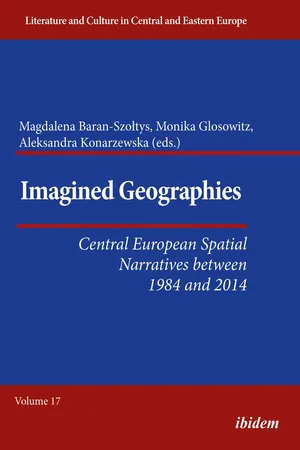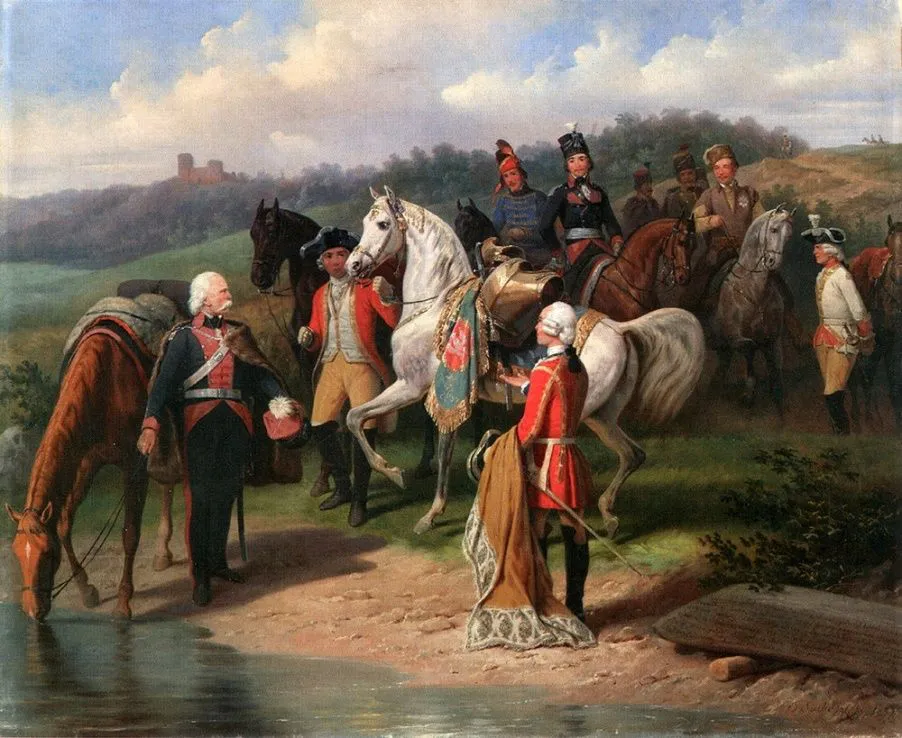
eBook - ePub
Imagined Geographies
Central European Spatial Narratives between 1984 and 2014
This is a test
- English
- ePUB (mobile friendly)
- Available on iOS & Android
eBook - ePub
Imagined Geographies
Central European Spatial Narratives between 1984 and 2014
Book details
Book preview
Table of contents
Citations
About This Book
In 1984 Czech writer Milan Kundera published his essay "The Tragedy of Central Europe" in the New York Review of Books, which established the framework for disputes about the space "between East and West" for the following thirty years. Even today, the echo of those debates is still audible in spatial narratives. Discussing the way in which literary figures are positioned within new hierarchies such as gender, class, or ethnicity, this volume shows how the space of the imagined Central Europe has been de- and reconstructed. Special attention is paid to the role of the past in shaping contemporary spatial discourse.
Frequently asked questions
At the moment all of our mobile-responsive ePub books are available to download via the app. Most of our PDFs are also available to download and we're working on making the final remaining ones downloadable now. Learn more here.
Both plans give you full access to the library and all of Perlego’s features. The only differences are the price and subscription period: With the annual plan you’ll save around 30% compared to 12 months on the monthly plan.
We are an online textbook subscription service, where you can get access to an entire online library for less than the price of a single book per month. With over 1 million books across 1000+ topics, we’ve got you covered! Learn more here.
Look out for the read-aloud symbol on your next book to see if you can listen to it. The read-aloud tool reads text aloud for you, highlighting the text as it is being read. You can pause it, speed it up and slow it down. Learn more here.
Yes, you can access Imagined Geographies by Aleksandra Konarzewska, Magdalena Baran-Szołtys, Monika Glosowitz in PDF and/or ePUB format, as well as other popular books in Letteratura & Collezioni letterarie europee. We have over one million books available in our catalogue for you to explore.
Information
Topic
LetteraturaSubtopic
Collezioni letterarie europeeMagdalena Baran-Szołtys
University of Vienna, Austria
ANDRZEJ STASIUK’S GALICIAN ‘MIDDLE EUROPE’: HALF-DARK, EMPTY, AND BOUNDLESS
Introduction
If I had to invent an emblem for Middle Europe, I would put in the one-half darkness and in the other emptiness. The first one as a sign of non-obviousness, the second as one for an until now, untamed space. A beautiful emblem with slightly fainted contours which one can fill with his own imagination. Or with his dreams.1
This statement from the essay Dziennik okrętowy2 [Log Book] (2000) by Andrzej Stasiuk (b. 1960) describes his vision of ‘Middle Europe:’ a microcosm, which enables an imaginative, historical-philosophical re-construction of ‘Other Europe.’ It is intended to be read in the context of Europe’s 1989 political reconfiguration. This period inspired a noteworthy shift in literary interest in geography; which led to literature starting to construct geographical spaces, in which the concept of Central Europe is prominent. In this article I will focus on three questions, which will stake new ground in the existing body of work on Stasiuk, but also build on and update existing conclusions:
(1) What does East and West mean in this context and what meanings do those ideas have in Stasiuk’s poetics?
(2) What are the main features of Stasiuk’s Middle Europe and why did he choose these features?
(3 How is Stasiuk’s Middle Europe connected to the pre-existing concepts of Austrian Galicia, Kresy, and Sarmatia, and how does it differentiate itself from the popular concept of Central Europe?
I will argue that Stasiuk’s ‘Middle European’ space is (as quoted above) defined by ‘non-obviousness’ and an ‘untamed space’ ‘with slightly fainted contours.’ On the one side, this ‘untamed space’ is connected to the mythologizing concepts of Austrian Galicia or the Habsburg Empire in general as well as his Middle European ‘nowhere.’ On the other, the ‘Middle European’ space is limited by restrictive concepts of East and West, and oscillating between these two definitive concepts.

Figure 13: Mohort (1859) by January Suchodolski (1797–1875). Public Domain.
I will draw mainly on Stasiuk’s works from the 1990s because I will later argue that these works represent a different space and a different kind of Central Europe compared to his later publications. My analysis will focus on three of his works: the programmatic essay Dziennik okrętowy, in which he attempts to conceptualise his own poetics, as well as the stories Dukla (1997)3 and Opowieści galicyjskie4 [Tales of Galicia5] (1996). I will use the term ‘Middle Europe’ when referring to Stasiuk’s concept and ‘Central Europe’ for general references to the topographical region or the concept defined anew in the 1980s and re-discovered by Milan Kundera.6
Magdalena Marszałek points out that after the years 1989 / 1991, there is a process of self-discovery in Central Europe—the part of the continent inspired by the changes of the political landscape. Thus Stasiuk’s essays paradigmatically represent the new literary mapping of Eastern Europe.7 Therefore, my analysis focuses solely on Stasiuk’s work from the 1990s as a negotiation of Polishness after the transition of 1989. The historical region of old Austrian Galicia plays an important but not exclusive role in this negotiation. In the 1990s and in the early 2000s, Stasiuk focused on the Beskid Mountains and the post-Galician space. Therefore, his concept of ‘Middle Europe’ from that time is based on these two regions. However, beginning with Jadąc do Babadag8 (2004) Stasiuk’s travel narratives start to reach further south,9 incorporating south-eastern Europe into the constructed ‘Middle Europe’ and as Jagoda Wierzejska argues,10 this provides an alternative to the linear East-West dichotomy. His latest publications deal with regions further east: Wschód11 [East] (2014) relates to Russia, China, and Mongolia, Osiołkiem12 [On a Donkey] (2016) covers Russia, Ukraine, and Asia.
Galicia, Kresy, Sarmatia
Stasiuk’s self-defined and self-proclaimed ‘Middle Europe’ intermingles with traditions of myth producing, transnational constructs like Sarmatia and Kresy. Although these constructs are often used to define a similar idea, they are referring to different concepts.
Galicia refers to the crownland Galicia and Lodomeria (1772–1918) which was an administrative region of the Habsburg Empire. Although this superficial and constructed character was derived from this region from the very beginning, as Larry Wolff prominently stated,13 today Galicia features an after-life in many national narratives and hence is a transnational phenomenon. Texts about travels to Austrian Galicia have been published since the late eighteenth century and influenced the representation of Galicia, both within and beyond the province. After 1989 a new wave of publications arose that explored Galicia; but even these contemporary texts and travels focus on a historical space that no longer exists. Nevertheless, this (post-)Galician space remains popular for travelers and 100 years later the Habsburg heritage still plays a crucial role during these travels and within the texts. Travelers are constantly updating the pre-established images and ensuring the continued existence of Galicia, with its specific Habsburg features. The old travel accounts used to present Galicia as the periphery of Austria-Hungary. The province was characterized as ‘wild,’ ‘backward’ and ‘barbaric.’14 These publications suggested that Galicia was a distinctive Eastern territory that needed to be enlightened and civilized by the new rulers. The contemporary travel narratives have been slowly transforming this picture. Galicia has become a nostalgic place, similar to Atlantis: a world of memory of one’s childhood, literature and history.15 Andrzej Stasiuk’s texts are part of this broader phenomenon. Multiethnicity and multilingualism are topics closely connected to the imperial Austria-Hungary in these new travelogues, being one of the Empire’s main features in these spatial narratives from the late twentieth century. In this multiethnicity, Jewish people have played a preeminent role. The Habsburg times are depicted as an opposition to the traumatic events following the collapse of the Empire. Stasiuk invokes the Habsburg heritage of the Danube Monarchy (so called ‘Kakania’), especially the old Austrian crownland Galicia and Lodomeria as a basis for his literary construction of Europe outside the East-West dichotomy. Anti-historical, idiosyncratic descriptions based on personal memory dominate his perception of Galicia. The transnational (post-)Galicia is meant to be an integral part of ‘Middle Europe.’ Stasiuk locates his ‘Middle Europe’ exactly in the ‘historical ephemeral Galicia, which becomes an manifestation of the historical and geographical unstable Middle Europe.’16

Figure 14: Lemkos, an East Slavic minority of the Carpathian Mountains. Public Domain.
Galicia and the Kresy17 are two interrelated historiographical and mystifying concepts that often overlap in contemporary public discourse. They are clearly separated in their development, but both played an important role in the formation of Polish national identity. As memory spaces, they take on important functions in the national narrative by belonging to the Polish myth of the East,18 while Galicia is often seen as part of the Kresy in Polish discourse.19 While Galicia goes back to the actual existing crown land of Galicia and Lodomeria, the Kresy was o...
Table of contents
- Table of Contents
- Acknowledgements
- Introduction. Central Europe and Its 30 Good Years (1984–2014)
- A Narrative Construction: The Idea of Central Europe in Milan Kundera’s Writings
- Galicia: An Eastern or a Western Land? Remarks on Locating the Province in the Framework of the East ̶ West Opposition
- Andrzej Stasiuk’s Galician ‘Middle Europe’: Half-Dark, Empty, and Boundless
- Longing for the Empty Space— Nostalgia and Central Europe
- Author Information
- Illustrations
- Literature and Culture in Central and Eastern Europe
- Copyright